Right after I had signed the contract of purchase of my King´s Cruiser 33 – after all built in 1975 – it was clear for me to have a complete interior refit of that yacht. Equipment, colors, and the different materials had been getting a bit long in the tooth over the cause of some 40 years now. Albeit not really obstructed my boat shows a load of signs and traces of her previous owners and thousands of miles cruising. Refit of the interior – that means a new decking as well. The current one was in a top condition, to be honest, but what was bothering me all the time was it being very slippery and thus dangerous, especially for my children. All right, here´s a new project …
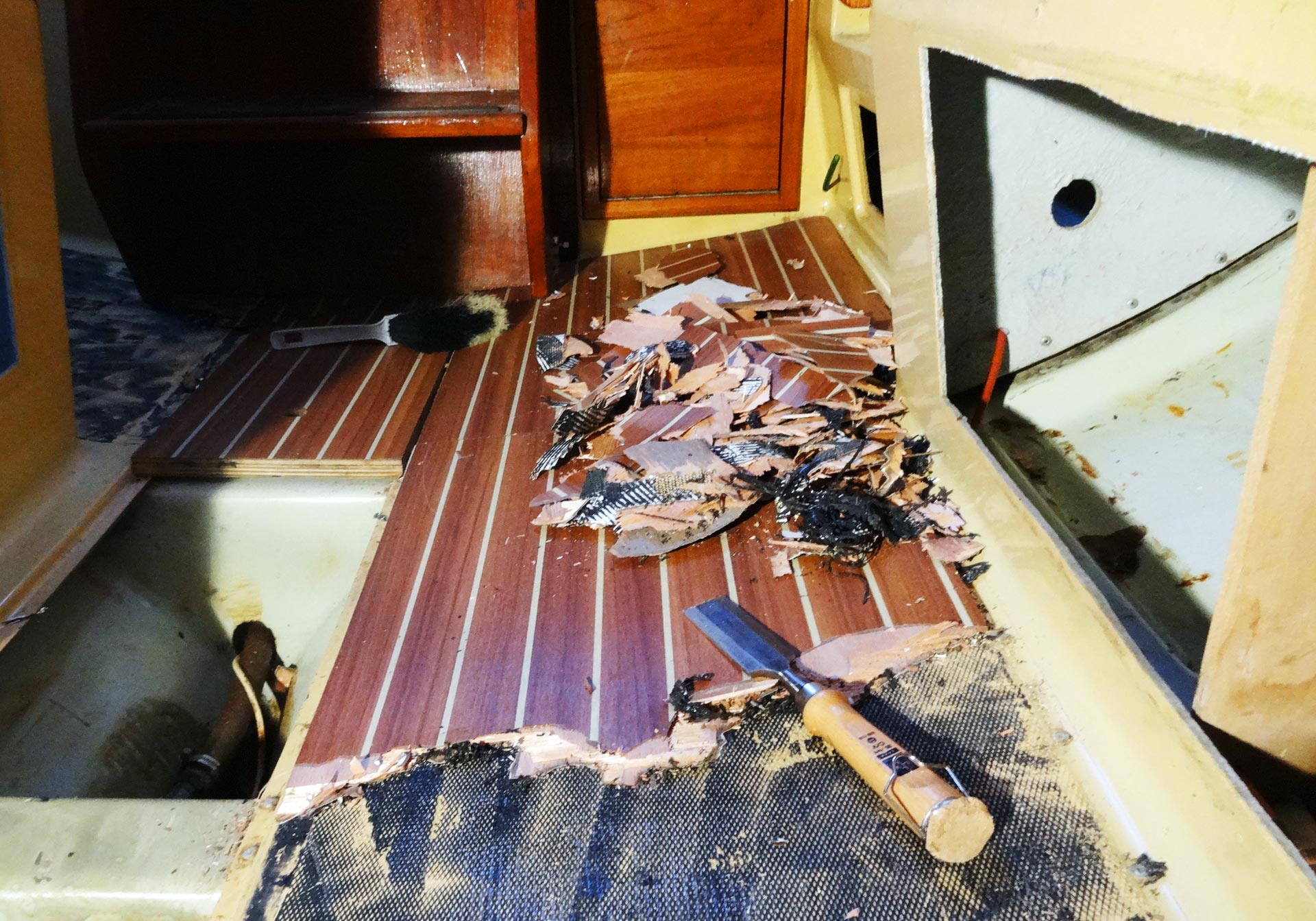
It was really tough work to get rid of that old deck. I had to hammer it off with a heavy chisel centimeter by centimeter. A kind of brutal effort to get the stuff off the GRP-structure (here´s a complete article on the first milestone of my refit-project). When roaming the Hanseboot-fair I took a lot of close ups of modern sailing yacht´s decking to get an impression of nowaday´s workmanship and of course I visited several stands of decking companies offering their products and services. Since at least then this very question was inside my mind: Should I go for real Teak or artificial plastic stuff? At the stand of Rosch Yachtservice I got the chance to talk to Ralph Schiecke who was answering my thousand and one questions and offered me a visit to his company, which I took gladly to get to know more about Teak-Imitation for a yacht´s decking, what it is made of and how it is produced and adjusted accurately for every individual yacht.
Real wooden Teak-Deck: A thing of the past?
What do we like most at first sight when we take a look onto a ship. Her rig. Her fine lines. Maybe. But a nice wooden deck is what jumps into our eyes as well. Bare GRP-decks may have their pros – especially in really hot conditions like the Caribbean or the Pacific Dream Islands and besides the fact that almost every modern yacht is nowadays made of plastic a lot of owners opt for a deck made of real wood. Teak, as to speak frankly. A nice wooden deck is more than a pure reminiscence on the good old days of sailing on one´s own ship. “Of course: A nicely crafted wooden deck made from real Teak is pure eye-candy”, Ralph Schiecke, who was founding his company with a companion back in 2010, employing some three people, is rhapsodizing: “But there are a lot of reasons why synthetic decks are on the rise. And that is more than a trend with brand new yachts as well as for the refit projects.”
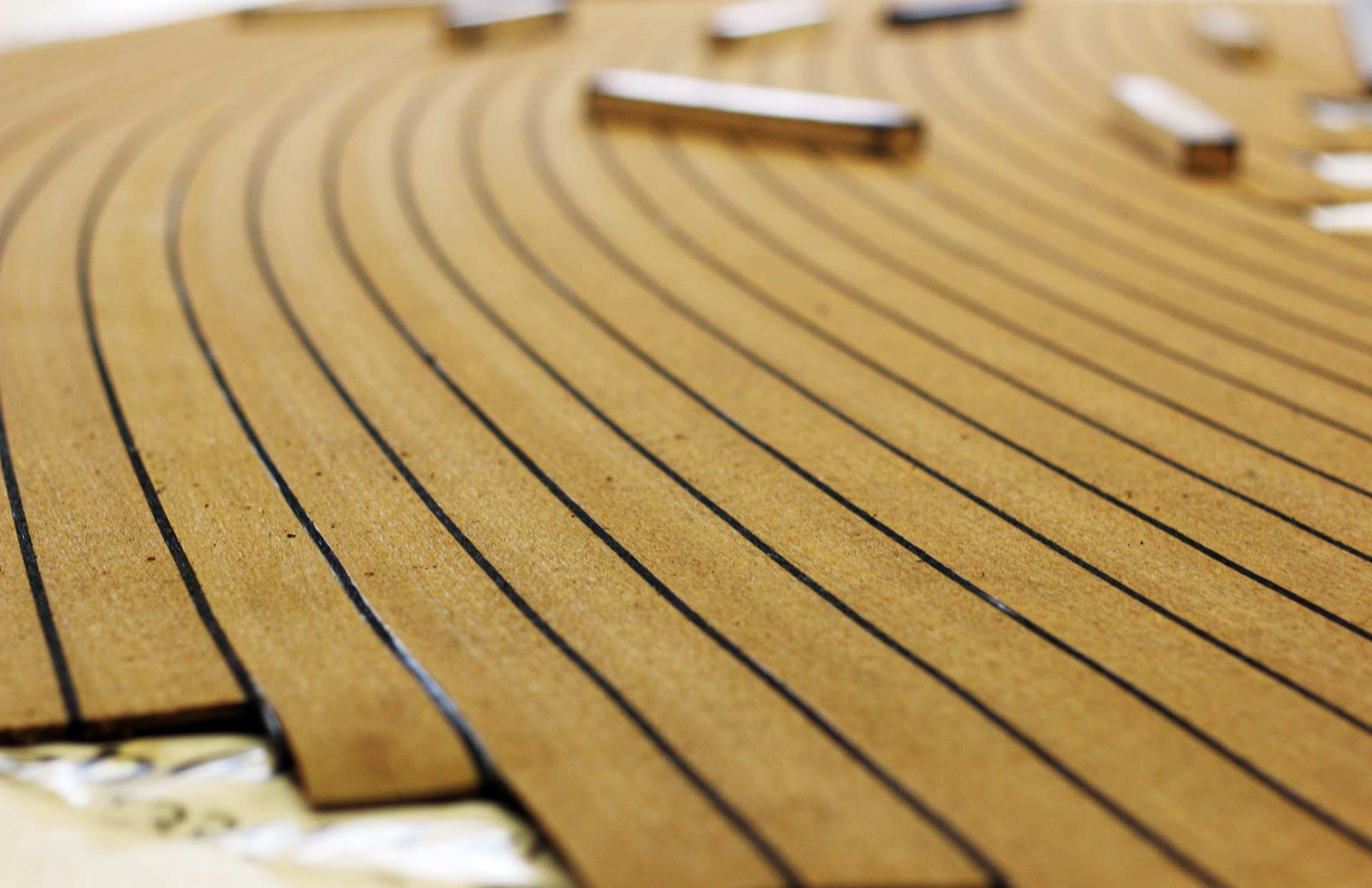
“Deckings made from real wood used to have a material thickness of 14 millimeters minimum. That was some 20 years back in time. You had quite a chunk of material on your boat and speaking of the material, the wood has been shown different grades as well. Better grades of course. Then the Teak was mostly tropical wood, having grown very slowly,” Ralph tells me when I hit his large workshop in the outskirts of Hamburg. He says, that after very strict rules on tropic lumber has been imposed – thank God! – you won´t find any of that high grade Teak. So, all the Teak-Decks made now do have to utilize a different Teak quality: “Today we have a material thickness of 5 to 6 millimeters, sometimes it´s even down to just 4 millimeters. The individual Teak blocks are therefore glued to a worktop which carries the blocks like a veneer if you want. These carrier worktops are made of ordinary wood of inferior quality – the big weak point of Teakdecks nowadays.” Because these worktops tend to soak up water and swell up to a point when the whole system can come off and ruin the nice decking – and this all just before the Teak itself is worn out! “Another thing is that the Teak itself being used on these days is coming from big plantations. There they prefer to have fast growing cultivars to be able to deliver. But a fast growth means soft wood. And that is of no comparison to the old, hard grade wood with high-quality and durable fibers from the jungle.”
The Advantages of a PVC-decking
Having really no practical reason to go for a real wooden decking, what are the advantages of a synthetical decking? Ralph doesn´t have to think too long: “First of all the biggest plus would be the longevity of a PVC-deck. A thoroughly crafted plastic deck will last well over 20, 30 years – and I am talking of the outside decking here. For the internal space of a yacht, the kind of decking you are looking for your yacht, this figure will be even bigger for sure.” PVC, according to Ralph, is just superior to a natural material when it comes to UV-persistence. “Our plastic is made UV-resilient and therefore will last ultralong. If crafted properly, which means that the decking should be glued thoroughly, it is constituting a near indestructible surface.”
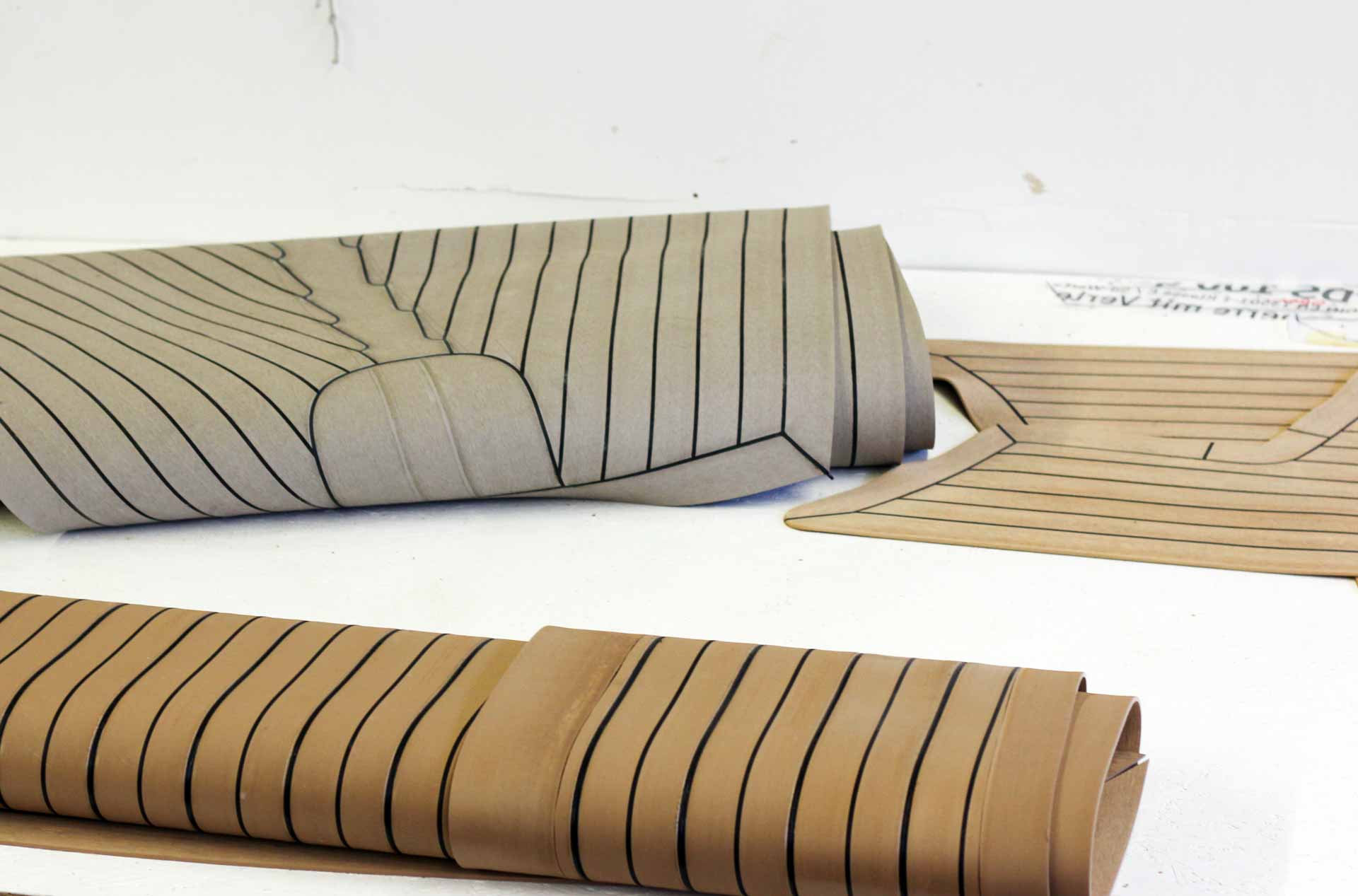
The surface texture of the Teak-Imitation is skid-proof and safe especially when wet. An undeniable plus for an outside decking. Decks made of PVC don’t wear out. If one should grind and sand a wooden deck every 10 to 15 years – which is thinning out the already thin blocks – there is no such need to do so with an artificial decking. To the contrary: “There is no abrasion of material whatsoever – especially the caulkings because they are made of the same material as well.”, says Ralph. “The joints of the individual blocks are a big weak point too with real wooden decks. The caulking material is mostly giving way first. It comes out, swells ugly. Repairing is elaborate and costly and when done sloppy will lead to even more damage sooner or later.” Last but least, PVC-deckings won´t develop stains or blotches (given everybody wears white feet as usual). “The one and only danger to a PVC-decking is Acetone.”
Many Companies, so much Brands. What are the differences between the PVC-decks?
FlexiTeak, TekDek or Permateak. There are so many brands bristling around on the market, one can easily loose the overview. Big companies with their big marketing budgets dominate the market, smaller companies such as Rosch Yachtservice appear in internet forums or by word of mouth. Where are the differences in PVC-deckings, or to say it frankly: Are there any? “Speaking of my own brand, A Rosch-Deck is not a re-branded industrial product of one of the big players.”, Ralph states clearly: “We do have our very own recipe of PVC and our own designs. The deck blocks are made exclusively just for us.” If you ask Ralph, most of the competitors do offer an unbalanced proportion of the width of a block to the caulking: “FlexiTeak for example has a 5,2 millimeters wide caulking. I find that looks unbalanced, that’s why Rosch offers a slightly finer width of 4,75 millimeters.”
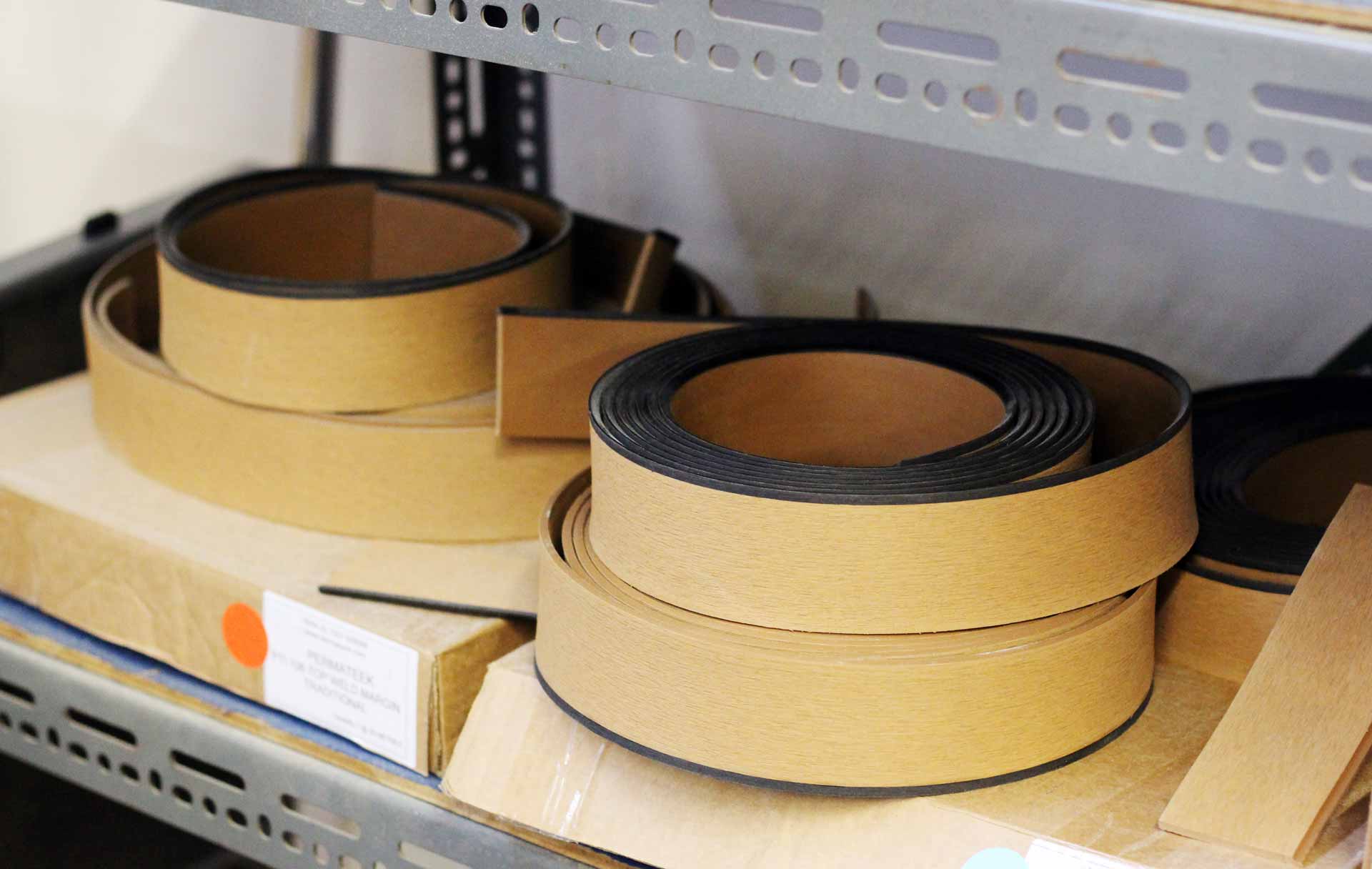
Another aspect are the gluing characteristics. Something one wouldn´t think of initially. “Before we offered our own Rosch-Decks we have been into the refit-business for several years. We have been able to collect invaluable experience with applying the products of our competitors. And what was bothering us most has been the somewhat floppy performance when it came to gluing the stuff to the GRP-surface. We found out it was due to the structure of the backside of the PVC-blocks. They simply wasn´t forming a solid connection with the boat itself.” Rosch-Deck has a somewhat finer structured backside with way better adhesive characteristics. “We could prove that our decking has far better adhesive properties thanks to this innovation.” A solid connection to the boat also insures a long lasting decking in the end.

“Just like it is done with real wooden deckings with Teak you have these alleged low-cost offerings. You will buy just a long, rolled up block of PVC-Teak and you can form your own designs by bringing the blocks together. We don´t like this product because a non-professional just can´t do it properly, no matter what they tell you.” The problem is the caulking, Ralph tells me. Especially these DIY decks do have disintegrating caulkings sometimes after only a few years. “I have seen stuff like this, the owners get desperate and try to counter the process by applying tons of Sika and other stuff. It´s crazy, because that even worsens the situation.” Rosch-Decks, as well as some other brands, do prefab bigger portions of the deck and deliver large parts. These bigger parts will be glued as a whole to the boat which will naturally decrease the vulnerability of the caulkings: “Rosch-joints are welded and thus form an inseparable unit.” No matter which brand you go for, says Ralph, look for a partner who is solely engaged in the decking-business. “PVC-decks is a nice to have –service for some companies which are not really specialized in making high quality durable yacht decks. I have seen so many bloodcurdling things in this matter …”
It starts with a 1:1 Pattern
Taking a sightseeing tour in his workshop Ralph shows me some patterns of past projects. This is how every single new synthetic decking begins its life. “The principle of utilizing patterns is the same with all products on the market”, Ralph says. “The client will make a 1:1 pattern of the whole deck on his own and send it to the company. The easiest way is to buy a large roll of thick brown-paper and cut it into form with a scissors or carpet knife. This technique is well-proven with small projects.” A clear disadvantage could be that you have to work very precise which could cause rookies to re-try the cutting of one pattern a few times. Besides, brown-paper can get wet easily and rip apart. It´s just fragile. But that´s virtually negligible for my own refit-project: Because I do want to renew my internal decking I do have only small parts to cover and don´t have to be aware of moisture.
It´s a different talk when it comes to bigger ships and external deckings. “Clients can opt for a pattern-making service done by our crew. When we do the patterns we use transparent plastic canvas. We will roughly cut them to size and will then mark with an Edding the edges of the deck. You can virtually see when you make a mistake and correct it. No need to cut or restart. We achieve very accurate patterns with that technique.” Vapor-Barriers as used when building houses is the material of choice here.
How a new Yacht Decking is made
When the patterns arrive at the Rosch workshop they will be spread all over the huge working table. “The main thing, especially with bigger decks and bending blocks are referential markings which show the longitudinal axis of the ship on which we will adjust the decking.” That´s logical: Only in such way a decking can be produced thoroughly. “The blocks will be roughly cut and brought onto the pattern. The caulkings will be applied and welded to a solid unit.” Next step would be the fine cutting of the whole deck into the exact size and, if the client opted for it, the production of a haunch. When done properly the whole decking will – for the first and probably the last time of its life – be sanded smoothly and thus receives its final design.
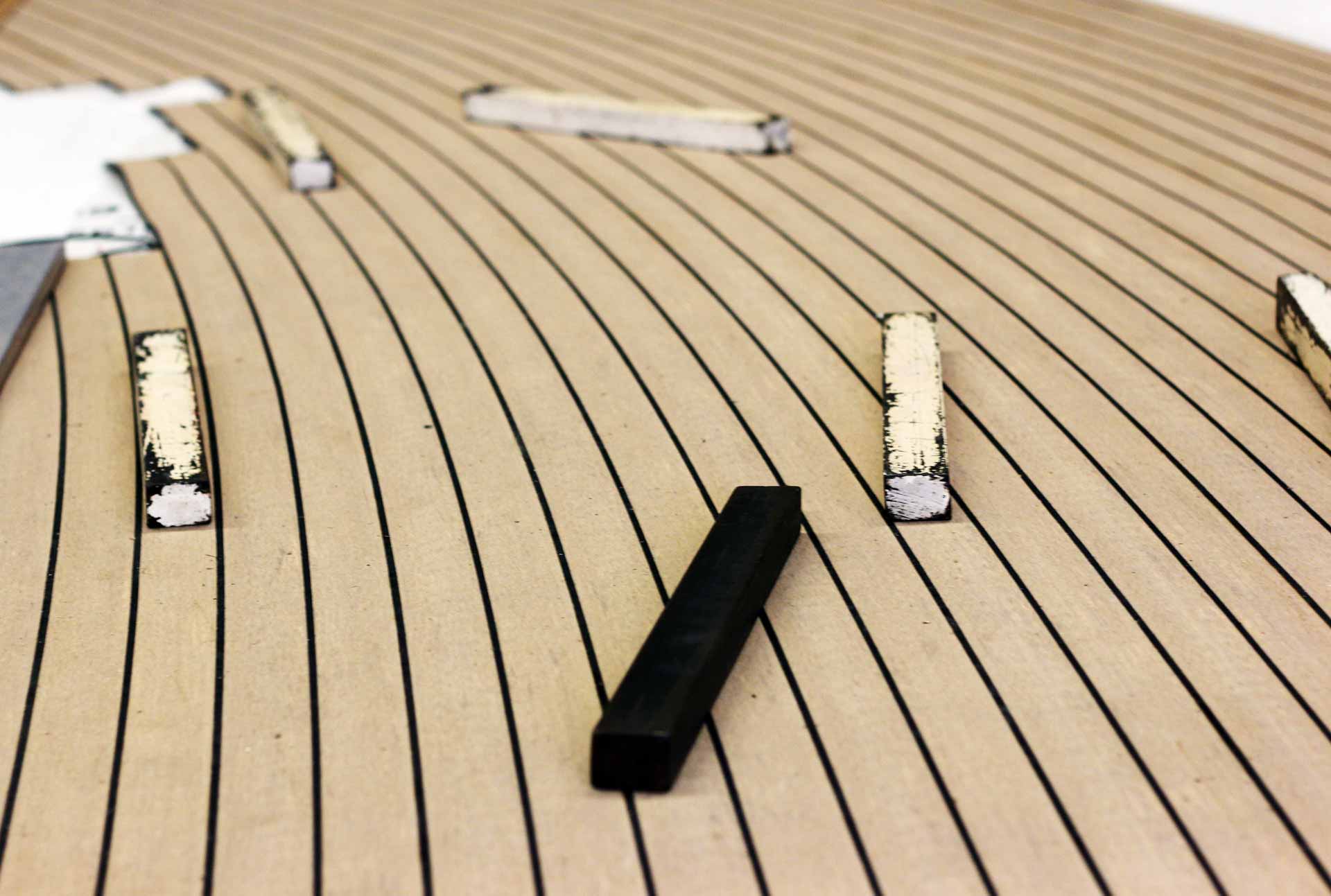
I haven´t produced these patterns for my King´s Cruiser 33 yet, but I come out from having to order 7 different parts for my internal decking. They won´t be bending, have a rather simple rectangular shape and won´t feature a haunch. I assume it won´t take a long time for Rosch Yachtservice to produce them – how long does the production of a PVC yacht-decking take? “For a project of the size of your ship I would calculate one week all in all”, says Ralph. Depending on the order situation and the time of the year it could as well mean longer waiting times. “Especially during the typical refit months we struggle to satisfy the crowd of our customers with a fast production.”
How expensive is a Yacht Deck made of synthetic Teak?
Cost and budget. A delicate topic – especially with refit-projects. To be honest, costs is a central question since most of us are not super rich millionaires. But here comes an all-clear ex-ante: When comparing all the different companies and their services it becomes clear that there are only minor differences when it comes to the price tags and the budget needed to afford a brand new synthetic decking. Ralph says, even if many brands are making big noise with “super prices” and “XY per cents off”: “A well-made synthetic deck will come at some 400 € per square meter – no matter which brand you may choose.” But he warns, the price shouldn´t be of too much interest when opting for a product, because if “you pay 10.000 € or just 9.500 € at the end this will make no real difference. What really makes the point is the quality of the material and the workmanship. And this is where companies can reduce costs and maximize profits.” Ralph proposes not to make a final decision based on a shiny stand on a fair but by talking to clients on the pier side or fellow colleagues of the sailing club. “Take a look onto a ship, ask for the brand and how satisfied the sailors are.”
No matter which PVC-brand you choose, the advantage over a real Teak-Deck is evident: Real wooden decks will come at 600 to 700 € per square meter and thus PVC offers a real potential to save money for other things needed on the boat. More so: “I am amazed that now some big brands do offer solely synthetic decking with their brand new builts.”, says Ralpt. And as I took a look into the 2015 catalogue of Dehler´s 38 feet cruiser I can see a range of 5 deck-designs. All synthetic. “But you know what? If I´d own a traditional Windjammer I´d rather go for a real wooden deck for sure. And here, in the upper price levels, you can easily pay for high grade Teak starting off at 1.200 €.”
Embarrass de Richesses: Which color suits my Ship?
At Rosch Yachtservice the client can choose from a color chart comprised of not less than eleven shades of Teak which can be combined with three types of caulkings. My own ship used to have a dark brown tone for the blocks and white-greenish caulkings. I want to lighten up the whole ship inside a bit so the old color scheme is out of question: “Really up to date with new ships is a grey weathered look. That´s really our top-seller”, says Ralph: “Together with clean black caulkings this design is both an eye-catcher for the exterior and interior with a rich contrast to the light veneers of the wooded boards and veneers of modern yachts.” But no alternative for a 40 year old cruiser …
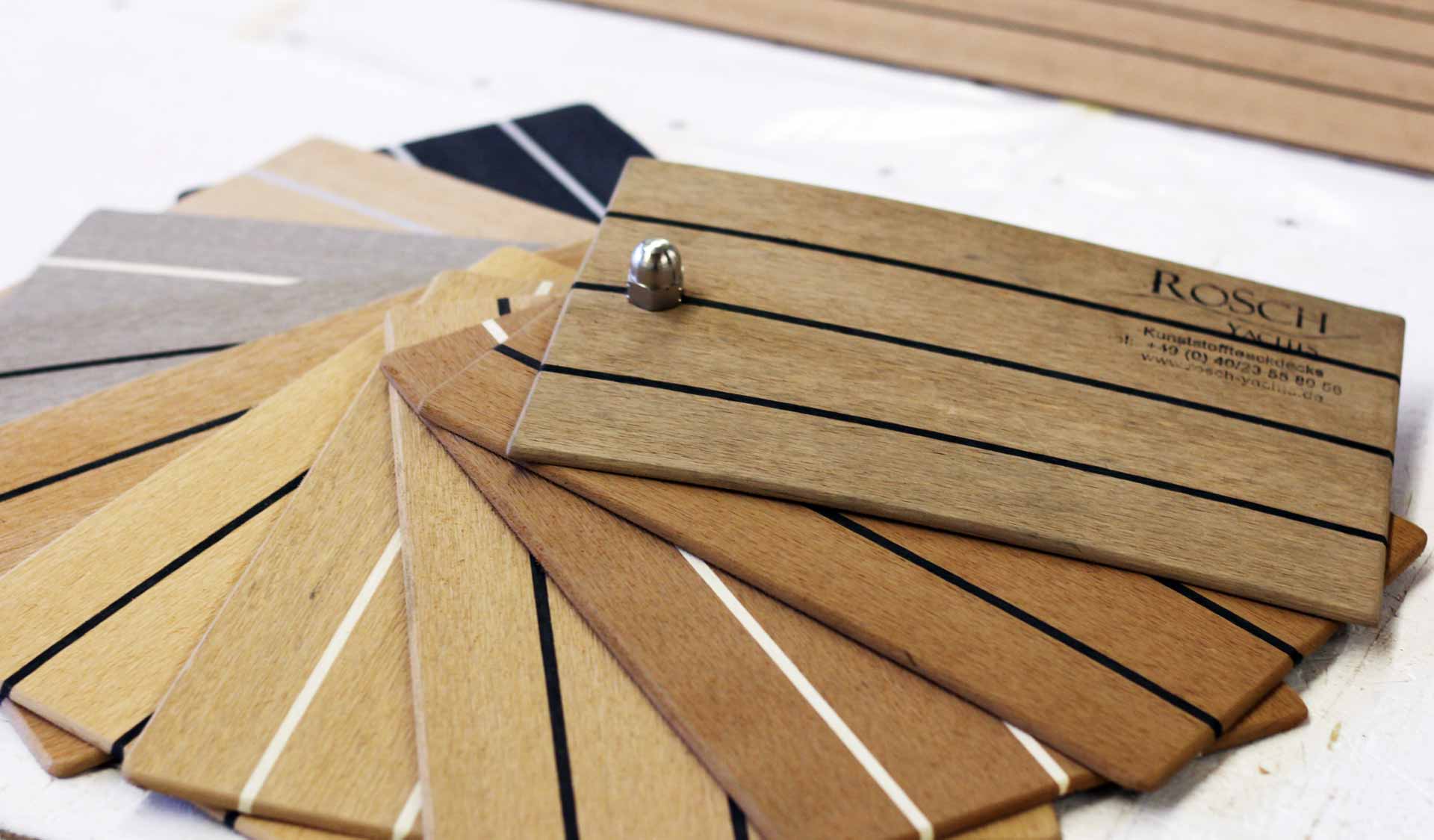
Raph has two advices here: “Go for a white caulking. For sure. No matter which color you choose, a white caulking will lighten up the interior, believe me.” He gives me two samples which I take home and discuss them with my wife. We opt for the lighter one. Because all internal GRP-surfaces will be repainted in shiny white over the coming weeks and all the cushion will be redone from dark-green to maritime blue. Leaving the wooden stuff inside being the only darker surfaces – a lighter decking could pose an interesting contrast to this color situation. “The choice of color will affect the character of a yacht for sure”, says Ralph: “Make your choice wisely.”
Next steps of the King´s Cruiser Refit-Project
I drive home from Rosch Yachtservice with a rich and clear picture of what to do. A roll of thick brown-paper is bought quickly. We have made our choice for the color of the new decking. And found a reliable and trustful partner for that milestone. But before the new deck can arrive, I do have some other steps ahead first: A new electrical wiring including an LED-lighting and of course the GRP-repainting. The next article on my refit-project of the new decking will sho how I produce the patterns and my new deck will come into shape at Rosch´s working table.
A big “Thank you!” to Rosch Yachtservice and Ralph Schiecke. If you want to know more about his product and service, don´t hesitate to browse to his Website or make contact.
